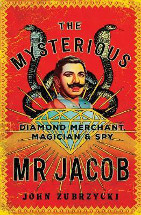The Mysterious Mr Jacob : Diamond Merchant, Magician and Spy by John Zubrzycki

Transit Lounge Publishing, 2017. ISBN 9780995359437
(Age: 16+) This story, claimed by William Dalrymple to be 'one of
the most exciting narrative histories to come out of India', is
indeed utterly fascinating. Set in the late 1800s and early 1900s,
the story is centred on Alexander Malcolm Jacob, who arrived in
Bombay in 1865. His parentage is unknown, seemingly because he
mostly tended to claim different stories at different stages of his
life. It is not a light narrative, its stories often complex and
their 'truth' quite often questionable, yet it is, at times, so
mysteriously fantastic that it seems as if he could have been a
character in a fictional fantasy.
Jacob became well-known in his own world of commerce, in the Indian
world of the time, particularly through his diamond-dealing, the
stones he sourced often being worth millions. However, he was also
known as a great magician, his complex tricks often being challenged
as impossible, therefore judged to be real magic, and therefore
unacceptable. As there appeared to be many for whom the tricks were
too difficult to comprehend, he was ironically criticized for this
very complexity, judged to be too close to real magic for the
audience, who ranged from the wider European community of
expatriates and those from the world of the Middle East, as it was
known at the time.
Keeping to the narrative genre, Zubrycki creates a believable and
indeed mysterious character whose fabulous wealth and control of his
world seem to have been impossible, given his background. Indeed, it
is this aspect that was so referred to so often in the work by his
critics. His capacity to create apparent magic, the strength of his
personality, his persuasive powers, his ability to buy and sell
works of art, particularly fabulous jewels, made him renowned across
British India, and abroad. He is said to have bought diamonds from
Australia, to have had friends in many countries, to have worked
impossible sleights of hand that could not be analysed, which added
to his mystery, and yet, before he lost his wealth, status and
friends, he appears to have been charismatic, mysterious and to have
been a consummate magician. He was interviewed by pragmatic
journalists, and even these non-believers wrote that there was
something unreal about this man's powers.
It would be a suitable book for older adolescents, as an informative
and challenging account of an unusual man. However, I would suggest
that this is not a book for younger readers because of its subject,
its complexity, its literary/historical nature, its references to
the real world of the Raj, and India in this historical period
(comprehensible with an understanding of India's complex history),
and because of the unresolved, and indeed mysterious aspects that
are part of its complexity.
Elizabeth Bondar